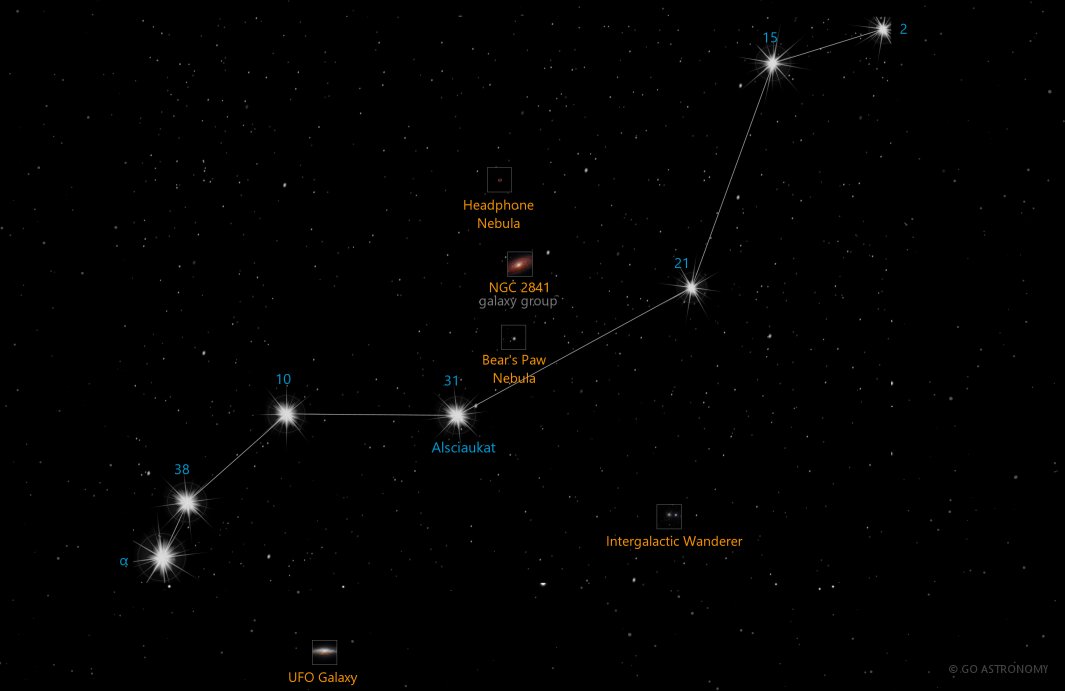Lynx, the Lynx (Lyn)
(links)
The Northern constellation of Lynx, the Lynx, is best viewed in Spring during the month of March.
Lynx is the 28th largest constellation. It's brightest star is Alpha Lyncis at magnitude 3.14. The boundary of the Lynx constellation contains 6 stars that host known exoplanets.
- Pronunciation:
- links
- Meaning:
- Lynx
- Genitive:
- Lyncis
- Abbreviation:
- Lyn
- Constellation Family:
- Ursa Major
- Hemisphere:
- Northern
- Quadrant:
- NQ2
- Visibility:
- 90° N - 55° S
- Best viewing month*:
- March
- Area:
- 545 sq. degrees
- Size:
- 28th largest
- Right Ascension (avg):
- 7h 44m
- Declination (avg):
- 48°
- Brightest star:
- Alpha Lyncis (3.14)
- Stars with planets:
- 6
- Messier objects:
- |
Brightest Stars in Lynx
The 10 brightest stars in the constellation Lynx by magnitude.
- Star
- Magnitude
- Spectral class
- Alpha Lyncis (α Lyn)
- 3.14
- K7IIIvar
- 38 Lyncis (38 Lyn)
- 3.82
- A1V
- 10 Lyncis (10 UMa)
- 3.96
- F5V
- 31 Lyncis (31 Lyn)
- 4.25
- K4.5III
- 15 Lyncis (15 Lyn)
- 4.35
- G5III-IV
- 2 Lyncis (2 Lyn)
- 4.44
- A2Vs
- HD 77912
- 4.56
- G8Ib-II
- 21 Lyncis (21 Lyn)
- 4.61
- A1V
- 27 Lyncis (27 Lyn)
- 4.78
- A2V
- HD 82741
- 4.81
- K0III
Double Stars in Lynx
These are the brightest and easiest-to-find double, triple, and quadruple star systems in the constellation Lynx. Also see all star clusters.
- Star system
- Magnitudes
- Type
- 12 Lyncis
- 5.4, 7.0
- double
- 19 Lyncis
- 5.8, 6.7
- double
- 38 Lyncis
- 3.9, 6.1
- double
Star Clusters in Lynx
The most notable and easy-to-find star clusters in the constellation Lynx . Also see all star clusters.
Nebulae in Lynx
Notable and easy-to-find nebulae in the constellation Lynx . Also see all nebulae.
Galaxies in Lynx
The most notable galaxies in the constellation Lynx. Also see all galaxies.
The Obscure Feline
Lynx is a less familiar constellation nestled in the second quadrant of the Northern Hemisphere (NQ2). This relatively obscure star pattern offers a surprising array of astronomical delights, from intriguing celestial objects to a curious history, even if it requires a bit of effort to spot it in the night sky.
Historical Overview
The constellation Lynx is a relatively new addition to the celestial map, compared to the 48 ancient Greek constellations. It was introduced by the famous Polish astronomer Johannes Hevelius in the 17th century. Hevelius was known for filling in the gaps in the celestial sphere with new constellations. The choice of the name 'Lynx' was an amusing nod to the constellation's faintness; Hevelius jokingly suggested that observers would need the eyes of a lynx to see it.
Location and Main Features
Lynx stretches out over 545 square degrees between latitudes +90? and -35?. It is bordered by the constellations of Auriga, Camelopardalis, Cancer, Gemini, Leo, Leo Minor, and Ursa Major. Despite its considerable size, Lynx doesn't contain any particularly bright stars, which is why it is often overlooked by casual observers.
Major Stars
The brightest star in Lynx, Alpha Lyncis, shines at a modest magnitude of 3.13, making it a third-magnitude star. Despite being the alpha star, it doesn't possess a traditional name. Alpha Lyncis is a red giant situated approximately 203 light-years away from our solar system.
Other significant stars in the constellation include 38 Lyncis, a triple star system with an observable binary component, and the variable star known as YY Lyncis.
Deep Sky Objects
While Lynx might lack in bright stars, it makes up for it with its selection of intriguing deep-sky objects. For instance, it harbors NGC 2419, an intriguing globular cluster that's sometimes referred to as the "Intergalactic Wanderer" due to its significant distance from the Galactic Center. The cluster, however, is challenging to observe due to its faintness.
Another notable deep-sky object in Lynx is the barred spiral galaxy NGC 2683, nicknamed the "UFO Galaxy" because of its shape. It's tilted nearly edge-on as seen from Earth, which gives it an elongated, saucer-like appearance.
Observation
Lynx can be seen in its entirety from observers located at latitudes between 90 degrees and -35 degrees. The best time to observe this constellation is during the months of February and March. Due to the faintness of its stars, it is recommended to view this constellation from a location with minimal light pollution and on a moonless night. Binoculars or a small telescope can assist in observing the deep-sky objects present within its boundaries.
Lynx in Modern Astronomy
Even though it's not a standout constellation in terms of brightness or size, Lynx offers an interesting case study in astronomy. Its deep-sky objects provide scientists with various opportunities for study and research, while its position in the sky makes it a compelling object of observation for amateur astronomers seeking a bit of a challenge.
* Constellation shown for northen hemisphere skies. For the southern hemisphere, constellations appear rotated 180 degrees (upside-down and left-right reversed) from what is shown. Remember that seasons are reversed too - summer in northern latitudes is winter in southern latitudes.
** Circumpolar constellations are visible year-round in the hemisphere listed (and not at all in the opposite hemisphere).





